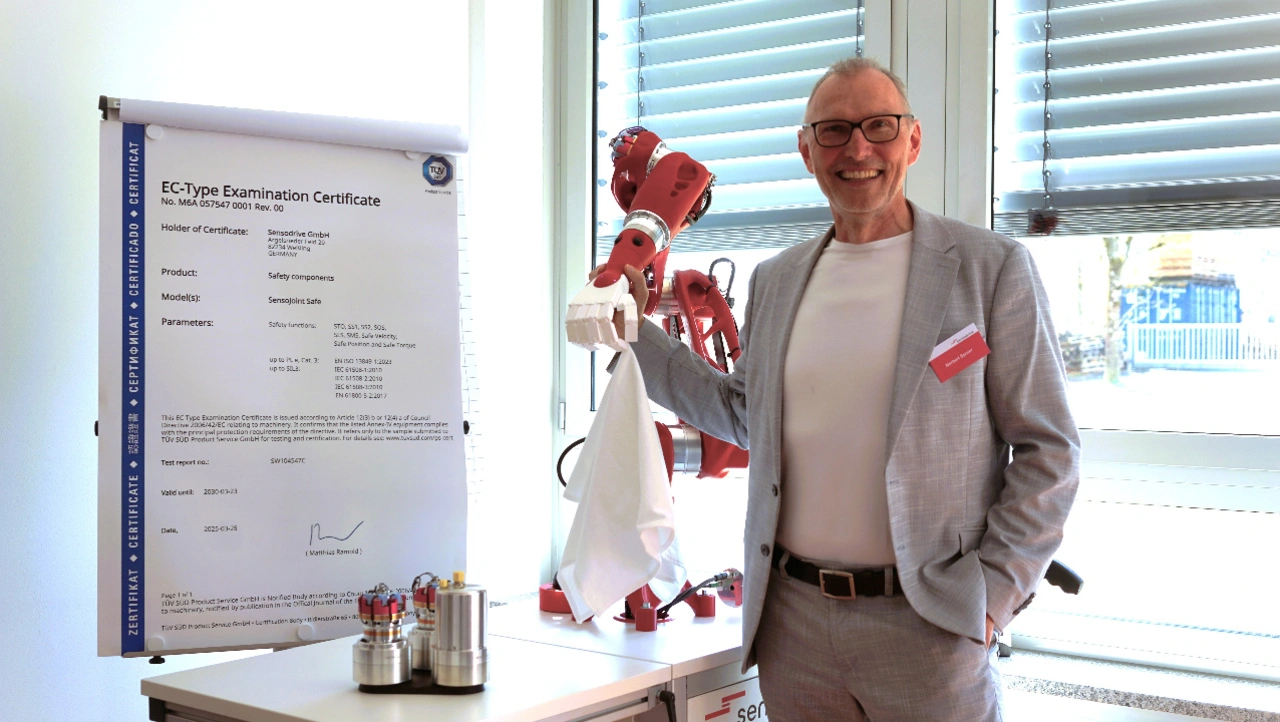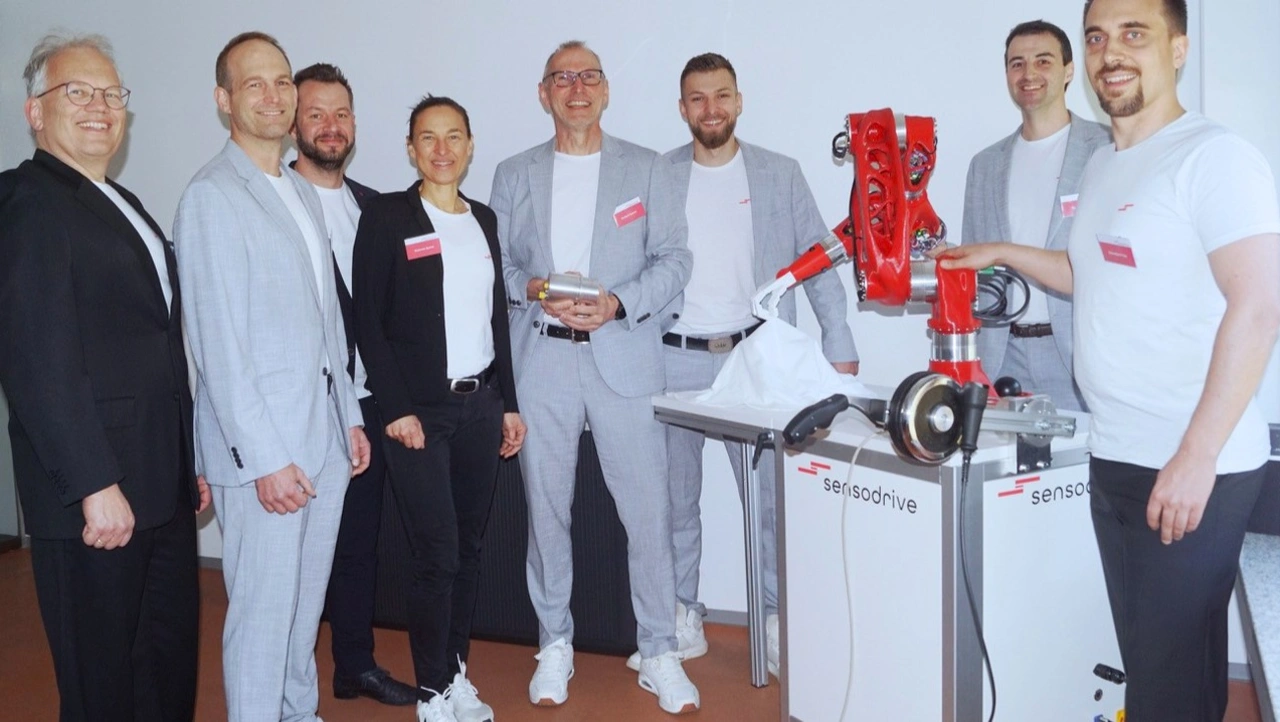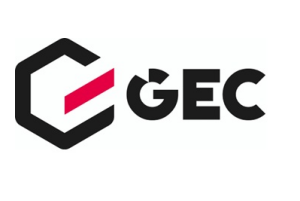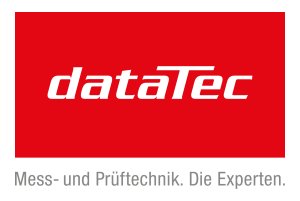For Industry and Medicine
The First Torque-Controlled Robot Drives with Full Safety
Building medical robots requires a lot of time, patience and money - especially for the development and certification of sensitive and safe drive joints. German Sensodrive promises a revolution with its "Sensojoint Safe" complete drives and aims to conquer the global cobot and medical market.
With the fully safety-certified and torque-controlled robot drives, every OEM should be able to build an industrial cobot or medical robot within a few months.
The robotic hand is holding the white cloth a few centimeters above the table - what lies underneath remains for now. A small movement then reveals the long-awaited innovation from Sensodrive: Franz Xaver Peteranderl, President of the Chamber of Crafts, turns a key, the robotic arm lifts the cloth and reveals shiny silver metal cylinders: the "Sensojoint Safe" complete drives from the Bavarian drive manufacturer celebrate their premiere in front of over 30 invited guests from science, industry, finance and politics.

According to Sensodrive, the torque-controlled robot joints are the first and only product of their kind worldwide to receive a full safety certification from TÜV Süd.
The certificate represents the hard work of over 20 years and the 50-strong team around Norbert Sporer is proud of the milestone they have reached. To celebrate the day, the managing director first plays music. The dialect song is about intrinsic motivation, the pursuit of one's own goals - even over hurdles - and the dedication required to achieve them. According to Sporer, the rocking piece was often needed during the development of the robot drives, at full volume, down in the basement. On the premiere day of "Sensojoint Safe", the song honors the Sensodrive journey to the present day - which should mark the beginning of international growth, especially in medical robotics.
Quantum Leap for Robotics Development
The certified Sensojoints are set to turn the development of sensitive robotic solutions on its head in several respects. Until now, manufacturers of cobots and medical robots have had to develop and certify their drives themselves - at immense cost and often years of effort. Instead, those who integrate the ready-to-install Sensojoint drives into their robotics solutions will free themselves from all this effort, says Norbert Sporer - and focus on the biggest advantage of the plug-and-play component: "The torque signal is guaranteed to be correctly detected" and then transmitted to the robot controller in real time via the functional safety protocol "Safety over Ethercat".
Depending on the type, the robo drives supplied in series are barely larger than a can of Coke and are certified in accordance with all relevant safety standards for the SIL3/PLe safety integrity level: IEC 61508, IEC 6206, IEC 61800-5-2 and ISO 13849. In addition, with this basis, robot developers can also implement other standards such as EN ISO 12100, EN ISO 10218-1, EN ISO 10218-2, EN 60204-1 and DIN ISO/TS 15066 much more quickly.
| Safety functions of the »Sensojoint Safe« |
|---|
| STO - Safe Torque Off |
| SBC - Safe Brake Control |
| SBT - Safe Brake Test |
| SS1 - Safe Stop 1 |
| SS2 - Safe Stop 2 |
| SOS - Safe Operating Stop |
| SP & SLP - Safe Position & Safely Limited Position |
| SV & SLS - Safe Velocity & Safely Limited Speed |
| ST & SLT Safe Torque & Safely Limitd Torque |
All safety functions were extensively tested prior to TÜV certification on the basis of valid industry standards. This included EMC tests, failure insertion tests - also in the thermal chamber and for humidity - extensive vibration and endurance tests as well as checks on the control technology and misuse. Around 1.5 person-years and several million cycles have gone into testing alone.
Nobert Sporer is particularly proud of the fact that his drives withstood the 50 Newton meters of force required in the overload test six times over - the robot arms carried loads of up to 300 Newton meters without any problems. "That's our watchword, it can't simply be bought," says the Managing Director happily.
Competitive Advantages for Medical Robotics OEMs

Business Development Manager Marek Polak then explaines to the audience in Weßling' Headquarter that, thanks to the complete drives, "cobots and medical robots can be developed in less than five months". "With our modular drive, manufacturers don't always have to reinvent the wheel," and promises of halving the time-to-market thanks to the extensive certifications. Development costs are even expected to fall by a seven-figure amount. In addition, there is no risk of development failures for OEMs, as is often the case with such complex medical systems.
Patented Torque Sensor Technology
At the heart of the Sensojoint drives are patented torque sensors that feature unique control technology with their "Advanced Control Algorithms". The position control with active vibration damping compensates for the smallest vibrations and unwanted resonance even under higher inertias and loads and reliably maintains a defined position - for the vibration-free positioning of surgical microscopes, for example.
| "Our drives are absolutely comparable to those installed in medical robotics systems such as those from Johnson & Johnson, Kuka or Intuitive." |
|---|
says Stephan Sporer, Custom Solutions Manager, in front of a demonstration robotic arm in Sensodrive's showroom. In the beginning, the company underestimated how important the manual guidance of robots is in surgery. Today, gravitational compensation, which compensates for the robot arm's own weight and enables feather-light hand guidance and precise robot teaching, is one of the outstanding functions of the Sensojoint technology. The precise torque sensor system records the forces on the six axes and enables the robot to react in real time.
Another key feature is the "force feedback", which makes it possible to carry out movements with a high degree of sensitivity. The surgeon receives haptic feedback - whether directly on the robot or via remote control - and can even feel the slightest resistance when touched. This technology has now become standard in the latest generations of surgical robots. This also includes collision detection as an integral part of the Sensojoint drives. Unexpected torques are used to detect collisions and immediately put the robot into a safe, but still active and therefore controllable, state.
Integrable Drives with the Finest Sensitivity
"This sensitivity is super important and is becoming increasingly relevant in development," says Dr. Ulrich Hagn, Engineering Director of Medtronic's Surgical Operating Unit. How a robot reacts when it collides with a patient is crucial, says the visitor from the immediate vicinity. The manufacturer of the Hugo surgical robot, whose MiroSurge technology also comes from the DLR, is "not yet" relying on external drive systems. Head of Development Hagn says: "Ten or eleven years ago, the technology was not yet ready, the components were not as small and the program control was not as integrable. Now it is."
"The maturity of the drive package is impressive," confirms Rüdiger Stahl from motor supplier TQ-Systems in Seefeld. For the managing director, the advantages include the sensitivity and strength of the torque sensors as well as the outstanding safety at platform level. It is now "very easy to build robotic systems".
To put it mildly, this is good news for Sensodrive and the now fully safety-certified Sensojoint drives. Automated robotic assistants, remote surgical assistants, medical holding arms, C-arms or microscope stands - in his presentation, Norbert Sporer showed logos of all the major medical robotics OEMs that use robotic drive systems and sees the "double-digit billion market" as the sweet spot for further company development. The "100 to 200 million" revenue he is targeting can also be seen as a promise for potential investors in attendance.
| "What will come 100% is medical. This market is huge!" |
|---|
Use in Cobots and Medical Robotics Worldwide
For the upcoming internationalization or better globalization, the drive manufacturer now needs partners who support and enable growth with sufficient capital - the good old bootstrapping is no longer sufficient for the step onto the world market. The safety certification of the complete drives should be an extremely good technical and economic prerequisite for this. (uh)
| From the Cellar into the OR |
|---|
|
Sensodrive is a German high-tech company that specializes in the development of force feedback systems, torque sensors and robotic drives with integrated torque measurement and control. The German Aerospace Center (DLR) spin-off started in 2003 with a rented basement room in the current headquarters in the immediate vicinity of DLR. Norbert Sporer brought tons of experience in lightweight robot development, torque sensor technology and a lofty vision for robot drives. Since then, Sensodrive, Kuka and the DLR have been cooperating in the field of medical robotics and cobots. After many challenges and a few setbacks, Sensordrive is now the only tenant in the three-storey office building. Because there were no investors after the dotcom crisis, the small company turned to bootstrapping to finance its big goal. Over the next 15 years, every cent earned from customer projects was put aside. "In 2020, we then focused our development team entirely on the Sensojoints," says Sporer, describing the switch in the business model to the company's own product and the reason for today's success. |







